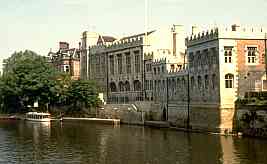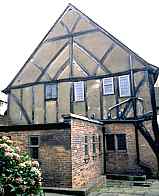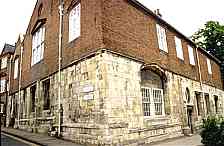 |
| Drama
(3) |
| The
manuscripts
of the English Mystery
Play cycles contain extensive stage directions as well as the actors'
spoken lines. The intricate staging arrangements of the N-town cycle indicate
that it was designed to be performed in a static setting. Those of York
and Chester indicate that they were enacted on pageant wagons moving through
the town. Each wagon and its play was the responsibility of a guild in
the city. |
 |
|
 |
|
|
The
city of York retains much of its medieval street plan and architecture,
including four splendid guildhalls. At top left, the town guildhall on
the banks of the river Ouse, restored after Second World War bomb damage.
At top right, some timbers at the ends of an unobtrusive brick clad building
show the medieval origins of the Merchant Taylors' Hall. It is supposed
to be open to the public, but I have never found out when. At bottom left,
the Merchant Adventurers' Hall is a heritage building that can be explored.
At bottom right, the hall of the guild of St Anthony is now the Borthwick
Insitiute for Historical Research. The brick clad upper storey hides a
magnificent timber framed hall. |
| The
York and Towneley manuscripts, dating from the mid 15th century, were a form
of master copy, or register, containing the text of all the plays as well as
addenda and alterations made for successive performances. As guilds changed
over the years, and scripts were altered, the performance changed. The manuscripts
represent, not a definitive text, but a segment of time encompassing a number
of varying performances. Some parts of the text are older than others. Even
though we are dealing with the written word, it is not immutable. There would
have been many other manuscript copies, of the individual plays at least, as
each guild would have had a copy of its own play and there would have been prompters'
copies to ensure smooth performances. |
| Further
evidence about the conduct of the plays comes from an entirely different manuscript
source; the records of the participating guilds. From there much can be found
about costumes, stage settings and props, food and drink for rehearsals and
instructions for participants. From this it is apparent that the staging was
elaborate, with some extraordinary special effects. References to fire and
gunpowder, and angels and devils bobbing up and down through different levels
on ropes make you wonder about their industrial safety record. The whole exercise
was a considerable enterprise for the participating guilds. There was quality
assurance as well, with fines for substandard performances. The records also
tell us that the plays began in the late 14th century, although the surviving
texts are much later. |
|
The
depiction in stained glass of the mouth of hell as the gaping jaws of a monster
derives from the plays, as here in a window in York Minster. (OK,
it's not a brilliant photo, but it's a long way up!) |
|
 |
The
fallen angels depicted in the stained glass windows of St Michael Spurriergate,
York, wearing (you guessed it!) angel and devil costumes like those worn in
the plays. |
|
It
is not to be thought that the scripts of these plays were the simplistic
interpretations of the town labourers; medieval versions of the Rude Mechanicals
of Shakespeare's A Midsummer Night's Dream.
The texts were drawn from works circulating among the educated clergy
of the day, and were probably the product of such literate men. The church
retained a master control, even though the events were staged outside
the church building. Neither were they simple Biblical paraphrases, or boringly didactic moralisings. They contained poetic language,
humour and parody, and an earthiness to appeal to the masses. When Cain
says to Abel, "Com kis myne ars!" the common folk knew for sure
he was a bad and uncouth dude. Various extrapolations were added to the
Biblical stories to expand characters and provide an entertaining dramatic
performance. After all, it was a big day out and the people had to be
enthralled from dawn to dusk at the height of summer. |
|
The
Mystery Plays died out, or were actively suppressed, at the Reformation, although
there were attempts to produce expurgated versions suitable for Protestant
tastes. Interestingly, they also faded away in Catholic countries, perhaps
having overstretched themselves in their ambition and their ability to be
kept under control by the church. The revival of performances of complete
cycles in their home towns of York and Chester in recent times shows them
developing a new significance. Continual wrangles occur between those who
want to stage traditional medieval productions and those who want the genre
to continue to develop, showing that it is again a living art form. |
|
| |
Some
local players perform a simplified production of a segment from the Mystery
Plays, the Fall of Adam and Eve, at a village bunfest in Flamborough, Yorkshire
in the 1970s. I once had the opportunity to go to the York Plays, but it rained
and they cancelled. I'm sure they wouldn't have done that in the middle ages! |
|
Perhaps
the most fascinating story about this genre of play in modern times is
that of one of the most famous, the Oberammergau Passion Play. There was
no medieval tradition of a Passion Play in this Bavarian town, but an
outbreak of plague in the 17th century resulted in 1633 in the erection
of a symbol of the crucified Christ, and in 1634 a play was performed
in the cemetery above the graves of the recent plague victims. The oldest
script of the play dates from 1662, but indications are that it was largely compiled
from older texts, including a 15th century play. In 1674 the script was
expanded using other medieval texts. Through the 18th and 19th centuries
the play became more elaborate in production and increasingly patronised.
In 1934 Hitler attended. The publicity for the play was given a certain
ideological spin that year. It was not performed again until 1950, when
it was presented as part of the post-war reconstruction of Germany as
a nation of Christian tradition. Productions have continued, with ever
increasing audiences, but controversy has raged, not only over matters
of aesthetic, but about perceived anti-Semitic elements in the script
and restrictions on participation by married women. The play continues
to arouse issues of significance in the modern world. |
|
The
Mystery Plays were grand productions for special occasions. They may be the
best known form of medieval drama today, but they would not have been the
most frequently performed. Many simpler genres of plays existed in both the
religious and secular domains. The appearance of a diversity of dramatic forms
appears at about the same time as the Mystery Plays, beginning in the 14th
century and expanding through the 15th. At least, that is how it appears in
the literate record. What was happening in the oral tradition is much harder
to determine. |
|
continued
 |
 previous page
previous page |
 Categories
of Works Categories
of Works |
|
 |
 |
 |
 |
 |













